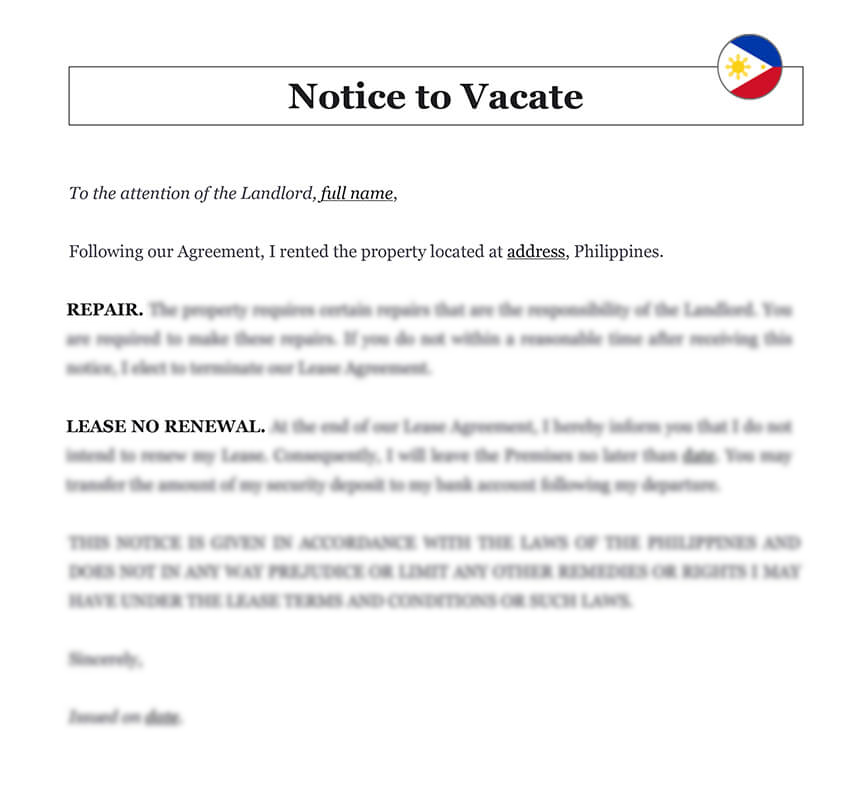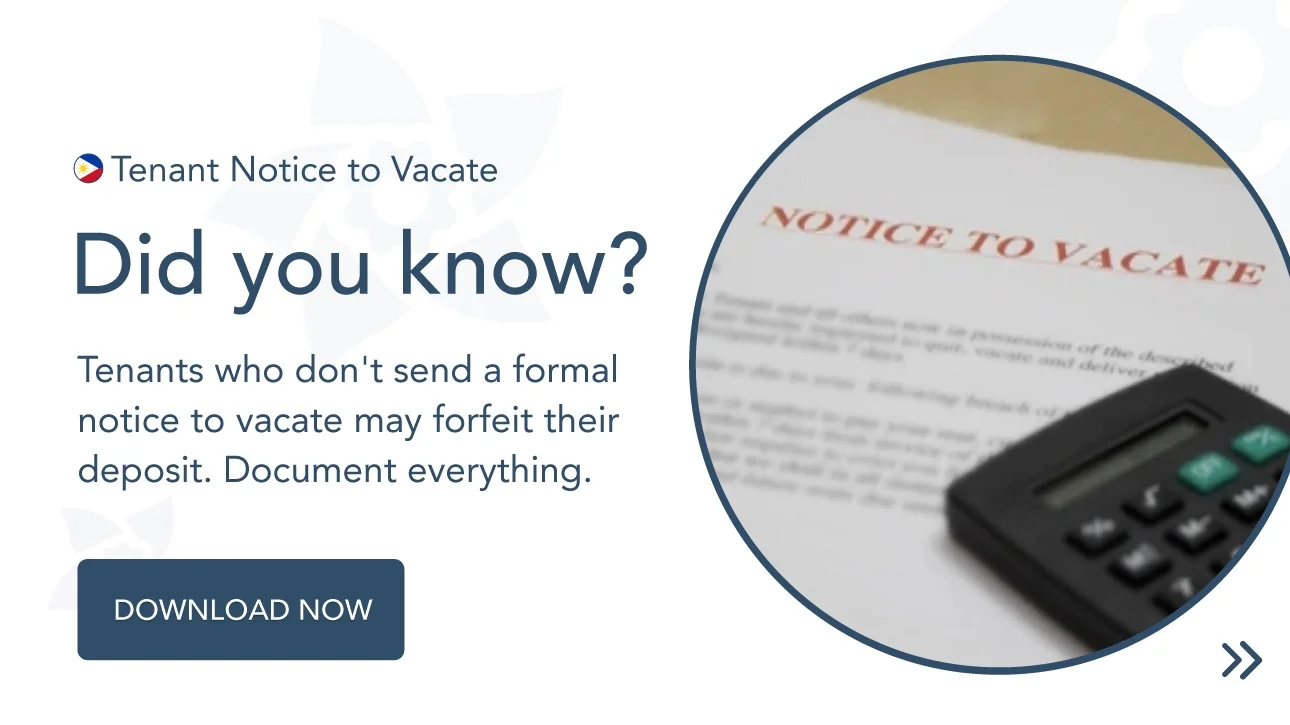Ready to use legal template
Drafted by experienced lawyers
Compliant with Filipino law
Ready to use legal template
Drafted by lawyers
Compliant with Filipino law
Home › Rent your property › Notice to vacate
Learn more about Notice to Vacate Letter in Philippines
The Notice to Vacate is a formal notification sent to the landlord by the tenant advising him of his desire to terminate the lease agreement for a number of reasons. The tenant has the option to terminate your lease at any moment. If the tenant wants to get his security deposit back, he must follow the notification period and provide a solid reason for breaking the contract. In the event of an owner default, Themis Partner provides a model of tenant breach of contract. Our legal staff may also create a letter suited to your case, granting you the legal right to retrieve your deposit.
Table of contents
What is a Notice to Vacate Letter?
A notice to vacate is a legally binding written document issued by a landlord to a tenant or vice versa informing the other party of a move-out date from an apartment, condo, home, or other residential rental property. A notice to quit letter gives the renter enough time to plan their move. It also gives the landlord ample time to plan renovations and start looking for renters. If the tenant gives the landlord a notice to quit, the letter should explain where to pay the security deposit if no property damage happened other than usual wear and tear.
When is a Notice to Vacate Needed?
Typically, notices to leave are delivered 30, 60, or 90 days before the lease expiration date. The leasing agreement should include the lease end date. If a landlord or tenant decides to break the lease agreement before the agreed-upon termination date, a notice to vacate is still necessary. Regardless of the circumstances, study the lease to determine the number of days required to provide notice without penalty.
When it comes to notices to vacate timescales, you must be aware of your rights as well as state and municipal legislation. Understanding this information will aid in determining when a notice to vacate must be delivered.
What is included in the Notice to Vacate?
1. The tenant’s departure date: Before deciding on a departure date, the tenant should check the lease. To prevent the contract from automatically renewing, the lease may require the tenant to provide notice a certain number of days before the lease period expires.
2. Include the date you sent your notice to quit letter to demonstrate that you did so within the time frame set in your Lease Agreement.
3. Landlord/property address: The address of your landlord may be discovered in your lease. The place where you submit rent payments is not always the same, especially if the landlord has a big number of properties or works with a property management business.
4. Request a final walkthrough: After you’ve removed all of your belongings, your landlord will generally ask for a last tour. You should discuss this with your landlord as soon as possible so that your security deposit can be restored.
5. Lease provisions: You may choose to review one or more lease rules that stipulate how much notice you must provide before terminating the lease and whether or not a walkthrough is required.
6. Forwarding address: This is where you will get your security deposit check and any other mail that must be forwarded to you.
What are the types of Notices to Vacate?
There are several sorts of notices to vacate letters for various circumstances. The sections below will assist both landlords and renters in distinguishing between various sorts of notifications and when to write which one.
Landlord to Tenant: Cause Notice to Vacate
A landlord’s notice to leave for reason is commonly sent to a tenant when the tenant violates the lease agreement, such as failing to pay rent, subletting the property without prior approval, having unauthorized pets or visitors, or other lease breaches. Consider a cause notice to leave as a warning rather than an eviction notice, which is normally issued when a tenant continues to occupy the property after their lease has expired or has been canceled.
When you prepare a reason notice to vacate as a landlord, you must frequently indicate the amount of time to fix the infraction or issue that breached the lease agreement.
Tenant to Landlord: Cause Notice to Vacate
A tenant gives his or her landlord a cause notice to terminate the lease when the landlord violates the lease agreement or the premises becomes uninhabitable or hazardous. For example, the property became uninhabitable as a result of needed repairs that were not completed on time. Other instances of crucial repairs include neglecting to fix a damaged HVAC system or failing to deal with bug infestations or a broken toilet.
Both landlords and tenants should be aware of which repairs are considered necessary and which are not. A faulty HVAC system in the winter or summer, for example, should be repaired within 1-7 days. Non-critical repairs, such as leaky faucets, small damaged appliances, or screen rips, take longer, often 10-30 days.
Tenant to Landlord: No-Cause Notice to Vacate
The most typical type of notice to quit letter is one sent by a tenant to a landlord. These notices to quit are frequently delivered a certain number of days before the lease expires. Or they are sent because of circumstances beyond the landlord’s control, and the tenant just wants or needs to break the lease. In any situation, the no-cause notice functions as a termination letter, alerting the landlord that a tenant will not renew his or her lease and intends to vacate the rented property.
It should be noted that a landlord’s no-cause notice to quit is unusual. It does happen when the landlord wishes to either relocate someone else or themselves back into the premises, repair or rebuild the property, or sell the property.
What must the landlord do before the tenant leaves?
| ➤ All electrical, maintenance, and water costs must be paid by the tenant. |
| ➤ The premises should be cleaned, and any damage caused by the tenant shall be repaired or replaced. |
| ➤ The owner must inspect the property and confirm that everything works properly. |
| ➤ The owner must sign and state that he has inspected the property and discovered no damage. |
| ➤ After ascertaining that all dues have been paid and no damages have occurred, the owner must reimburse the entire deposit amount to the tenant. |
| ➤ Finally, both parties can sign the rent deposit settlement agreement if necessary. |





